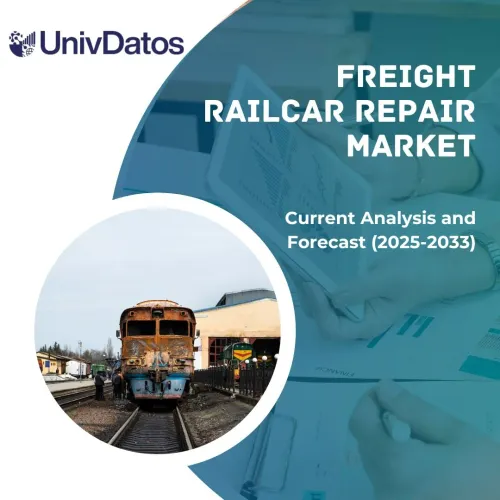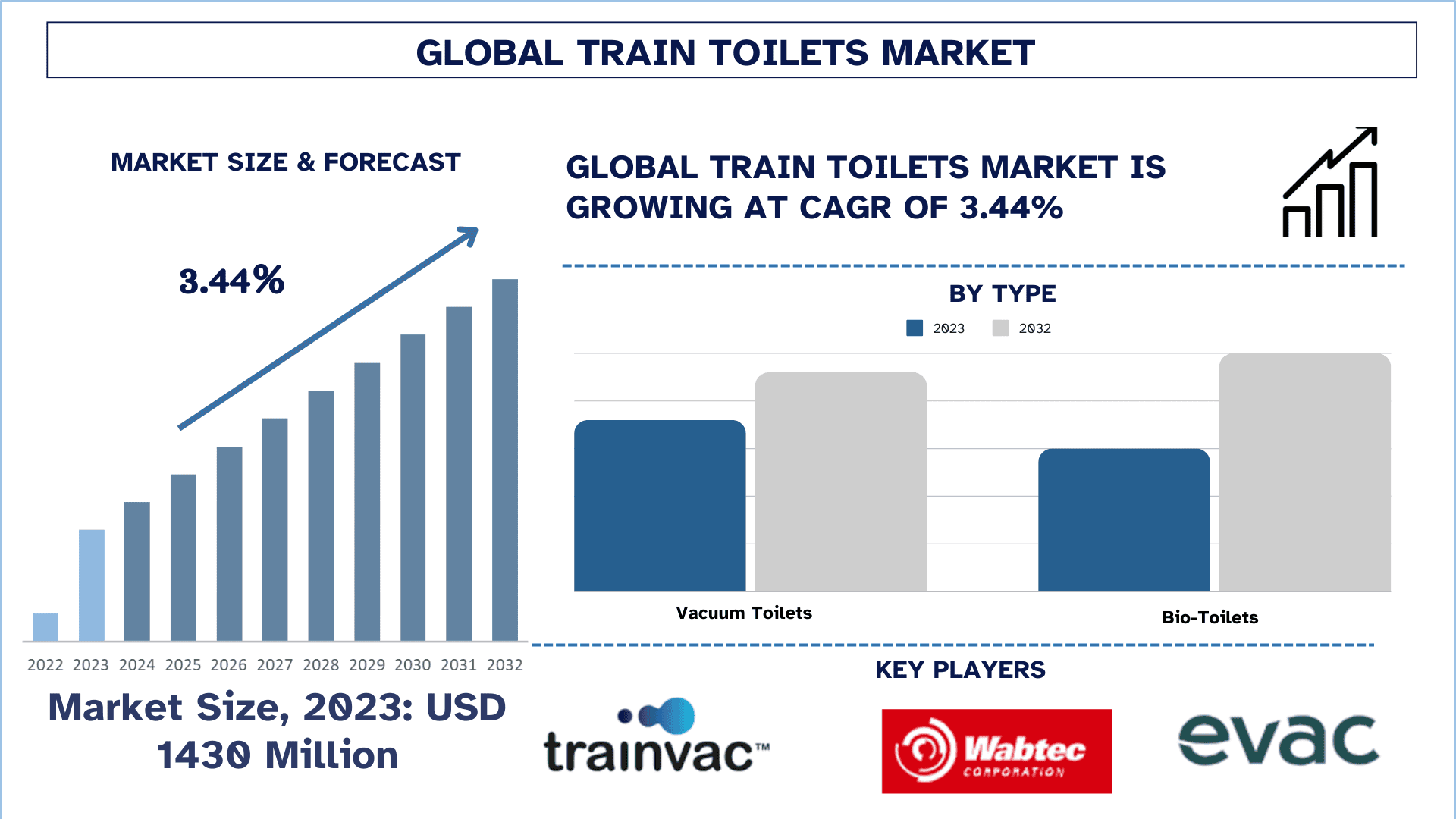
글로벌 기차 화장실 시장 규모 및 예측
글로벌 기차 화장실 시장은 2023년에 14억 3천만 달러로 평가되었으며, 예측 기간(2024-2032년) 동안 약 3.44%의 강력한 연평균 성장률(CAGR)로 성장할 것으로 예상됩니다. 이는 인구 밀도가 높은 신흥 지역에서 단거리 및 장거리 열차 통근에 대한 수요 증가에 기인합니다.
글로벌 기차 화장실 시장 분석
지난 몇 년 동안, 승객 이동 증가와 고속철도 네트워크의 출현으로 현대적이고 지속 가능한 시설의 필요성으로 인해 글로벌 기차 화장실 시장에서 주목할 만한 성장이 목격되었습니다. 기차 화장실은 승객의 일반적인 경험에서 필수적인 측면을 차지하며, 장거리 및 단거리 여행의 화장실 측면에서 위생, 편안함 및 편의성을 제공합니다. 기차 시스템의 확장에 따라 진화하는 승객의 기대를 충족하기 위해 개선된 기술, 친환경적이고 스마트한 온보드 화장실 솔루션을 추진하는 문제가 되었습니다. 대중교통 및 관광을 위한 옵션으로 기차 여행이 인기를 얻으면서 개선된 편의 시설에 대한 수요가 증가하고 있으며, 여기에는 최첨단 화장실 시스템이 포함됩니다.
글로벌 기차 화장실 시장은 2023년에 14억 3천만 달러로 평가되었으며, 예측 기간(2024-2032년) 동안 약 3.44%의 강력한 연평균 성장률(CAGR)로 성장할 것으로 예상됩니다.기차의 고급 화장실에 대한 수요 증가의 주요 원인은 승객의 편안함과 위생 개선에 대한 관심이 높아지고 있기 때문입니다. 그 이유는 물론, 점점 더 많은 철도 운영업체들이 전 세계적으로 전체 여행 경험을 훨씬 더 좋게 만들기 위해 동일한 발자취를 따라가고 있으며, 물 절약 옵션, 자동 세척 시스템 및 비접촉 기술을 포함한 현대적인 화장실 시스템을 더욱 보편화하고 있기 때문입니다. 이는 특히 고속철도 프로젝트와 장거리 열차에서 나타나며, 승객들은 더욱 고급스러운 편의 시설을 포함할 것으로 기대합니다. 예를 들어, 일본 신칸센 열차는 고효율적이고 깨끗한 화장실로 유명하며, 이는 글로벌 엔지니어링의 벤치마크가 되었습니다. 고객 만족도에 대한 관심 증가와 도시화와 함께 관광객 증가가 결합되어 우수한 품질의 기차 화장실 시스템에 대한 더 큰 수요를 창출했습니다.
전 세계 정부와 철도 운영업체가 온보드 편의 기능을 업그레이드하기 위해 수십억 달러를 현대화하는 데 투입하고 있으며, 이는 온보드 화장실의 위생 기준을 복원하여 외부 환경 규제를 충족하기 위함입니다. 따라서 화장실 디자인의 미래를 변화시켜 승객, 환경에 대한 증가하는 요구와 물, 폐기물 및 환경 영향에 대한 지속 가능성을 더 잘 충족합니다. 정부 정책은 또한 대중 교통 개선 및 2024-2032년 기차 화장실 시장에 대한 미래 수요를 촉진할 기타 환경 이니셔티브에 대한 자금 지원을 포함해야 합니다. 지속 가능한 교통 시스템에 많은 중점을 두면서 점점 더 많은 국가에서 더 많은 철도 시스템이 등장함에 따라 최첨단 친환경 기차 화장실에 대한 필요성이 더욱 증가할 것으로 예상됩니다.
글로벌 기차 화장실 시장 동향
이 섹션에서는 연구 전문가 팀이 식별한 글로벌 기차 화장실 시장의 다양한 세그먼트에 영향을 미치는 주요 시장 동향에 대해 설명합니다.
지속 가능성 및 친환경 솔루션
요즘, 환경 문제에 대한 국제적 인식이 높아짐에 따라, 지속 가능성은 기차 화장실 시장에서 가장 중요한 트렌드가 되었습니다. 정부: 철도 운영업체 및 제조업체는 기차 운영의 환경 영향을 줄이기 위해 총력을 기울이고 있습니다. 개발 중인 기술에는 물 없는 화장실 및 폐기물 에너지 시스템과 같은 친환경 화장실이 포함됩니다. 이러한 기술은 특히 물을 구하기 어려운 장거리 열차에서 물 없는 화장실의 사용성을 높입니다. 폐기물 에너지 시스템은 인체 폐기물을 사용 가능한 에너지로 변환하는 또 다른 기술이며, 이는 생태 발자국을 줄이는 데 도움이 됩니다. 화장실 건설에 사용되는 폐기물 및 생분해성 재료를 완화하는 것과 같은 다른 혁신도 있으며, 이는 지속 가능한 철도 여행에 대한 관심을 높입니다. 이 여행 트렌드는 탄소 발자국을 줄이고 친환경 여행 솔루션을 만드는 글로벌 노력과 일치합니다.
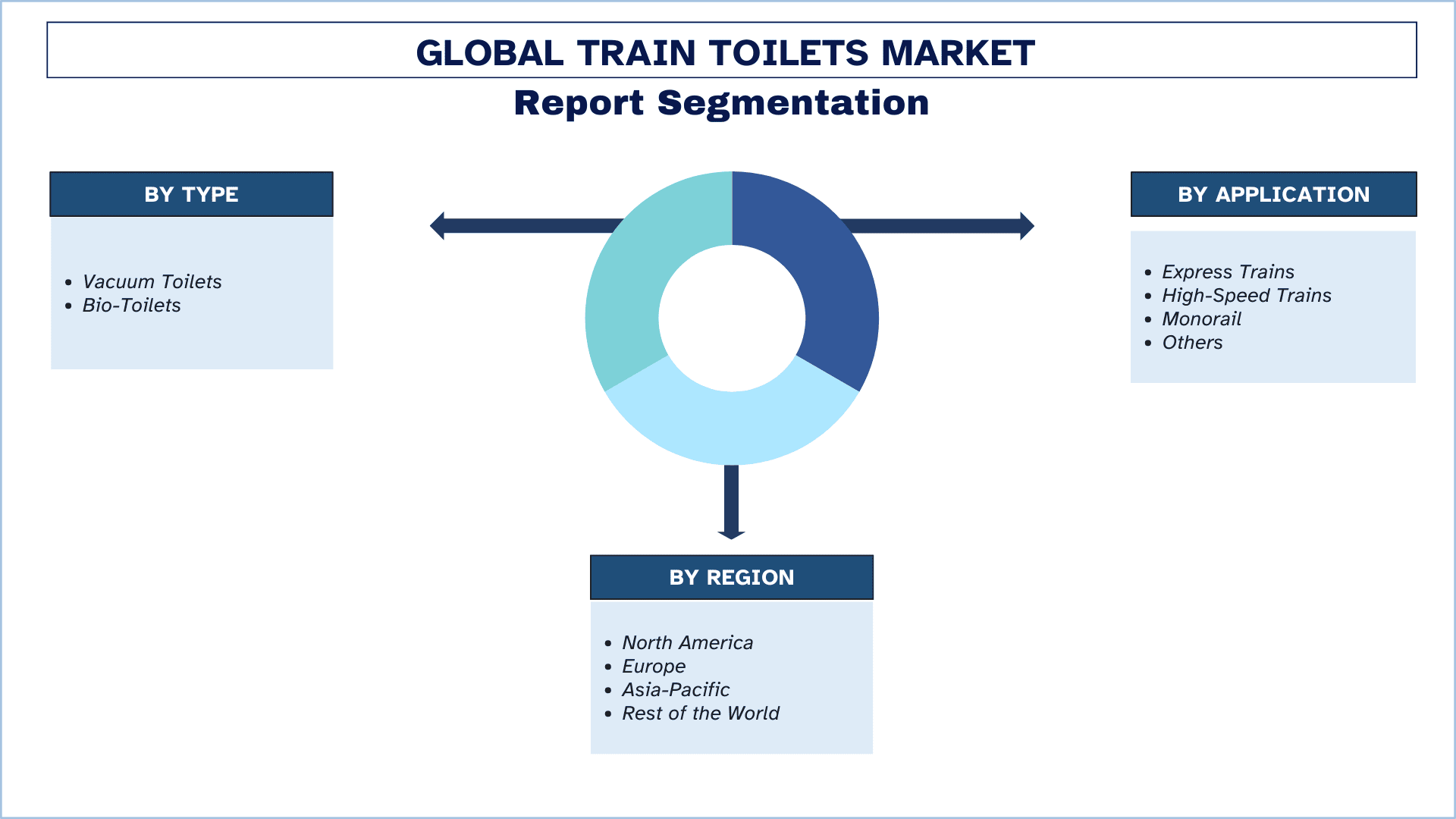
아시아 태평양이 예측 기간 동안 주요 시장 점유율을 차지할 것으로 예상됨
아시아 태평양 지역의 기차 화장실 시장 기차 부문은 아마도 전체 철도 산업에서 가장 빠르게 움직이고 역동적인 부문 중 하나일 것입니다. 이는 승객들의 청결 및 위생과 함께 더 나은 시설에 대한 수요 증가를 반영합니다. 중국, 인도, 일본, 대한민국과 같이 철도 네트워크가 확장되고 향후 몇 년 안에 더 확대될 가능성이 있는 모든 국가에서 온보드 시설, 특히 화장실이 정부와 민간 부문의 우선순위가 되고 있습니다.
인도와 중국과 같은 지역에서는 도시화와 중산층의 물질적 성장에 따라 철도 서비스의 신속한 현대화에 대한 필요성이 증가했습니다. 자동 세척 시스템, 절수 기술 및 친환경 기술과 같은 기차 화장실 기술의 혁신은 더 많은 사람들을 끌어들이고 있습니다. 이러한 첨단 기술의 채택은 환경 지속 가능성에 대해 우려하고 기차 시스템에서 물을 절약해야 할 필요성을 느끼는 사람들의 증가에 의해서도 추진되고 있습니다. 많은 주요 국가에서도 기차를 이용하는 승객 수가 점점 더 증가하는 추세를 보이고 있습니다.예를 들어, 인도 정부의 경제 조사에 따르면 2023-2024년 총 승객 수는 2022-2023년에 비해 5.3% 증가했습니다.
일본과 중국 및 해당 지역의 다른 국가에서 고속철도 트렌드가 나타나면서 더 큰 편안함과 위생에 대한 기대가 높아지고 있으며, 이는 화장실을 포함한 온보드 시설의 개선으로 이어지고 있습니다. 이러한 기차는 구형 기차에 비해 현대적이고 깨끗한 화장실 시스템으로 만들어졌습니다.
전반적으로 아시아 태평양 지역의 기차 화장실 시장은 승객 경험의 변화에 부응하기 위해 시스템을 수시로 업그레이드하려는 국가들의 노력을 통해 완만하게 증가할 것으로 예상됩니다. 주요 업체들은 위생, 편의성 및 지속 가능성을 결합한 화장실 시스템을 혁신하는 데 주력하고 있습니다..
2024-2032년 동안 기차 화장실에 대한 수요는 더욱 증가할 것입니다..
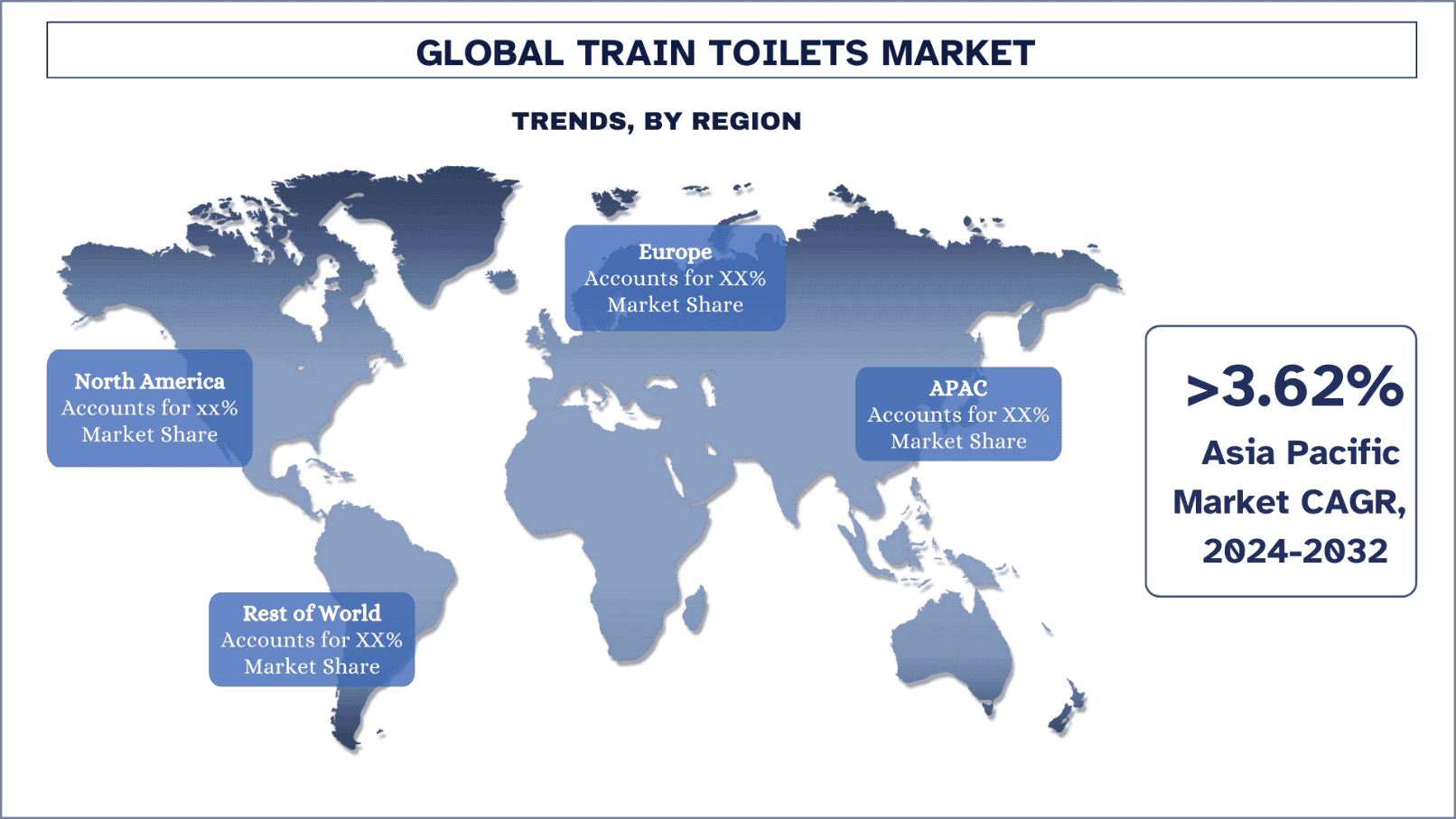
글로벌 기차 화장실 산업 개요
글로벌 기차 화장실 시장은 경쟁이 치열하고 분열되어 있으며, 여러 글로벌 및 국제 시장 참여자가 존재합니다. 주요 업체들은 파트너십, 계약, 협력, 신제품 출시, 지리적 확장 및 인수 합병과 같은 다양한 성장 전략을 채택하여 시장 입지를 강화하고 있습니다. 시장에서 운영되는 주요 업체로는 Trainvac Group, Kineco Limited, WABTEC Corporation, Huatie Tongda, EVAC, Goko Seisakusho Co., Ltd., Dowaldwerke, Zhuzhou CRRC Times Electric, Glova Rails 및 Arham Composites가 있습니다.
글로벌 기차 화장실 시장 뉴스
2024년, 중국은 160,000km의 운영 트랙과 40,000km의 고속철도를 건설했습니다. 2012년부터 철도 네트워크의 총 길이는 64.2% 증가한 반면, 고속철도 네트워크는 중국에서 392.2% 증가했습니다.
글로벌 기차 화장실 시장 보고서 범위
보고서 속성e | 세부 정보 |
기준 연도 | 2023 |
예측 기간 | 2024-2032 |
성장 모멘텀 | 3.44%의 CAGR로 가속화 |
시장 규모 2023 | USD 14억 3천만 달러 |
지역 분석 | 북미, 유럽, 아시아 태평양, 기타 지역 |
주요 국가 | 미국, 캐나다, 영국, 프랑스, 독일, 이탈리아, 스페인, 중국, 일본, 인도 |
프로파일링된 회사 | Trainvac Group, Kineco Limited, WABTEC Corporation, Huatie Tongda, EVAC, Goko Seisakusho Co., Ltd., Dowaldwerke, Zhuzhou CRRC Times Electric, Glova Rails 및 Arham Composites. |
보고서 범위 | 시장 동향, 동인 및 제약; 수익 추정 및 예측; 세분화 분석; 수요 및 공급 측면 분석; 경쟁 환경; 회사 프로파일링 |
포함된 세그먼트 | 유형별, 용도별, 지역/국가별 |
이 보고서를 구매해야 하는 이유:
이 연구에는 인증된 주요 업계 전문가가 검증한 시장 규모 및 예측 분석이 포함되어 있습니다.
보고서는 전체 산업 성과를 한눈에 간략하게 보여줍니다.
보고서는 주요 비즈니스 재무, 제품 포트폴리오, 확장 전략 및 최근 개발 사항에 중점을 두고 주요 업계 경쟁사에 대한 심층 분석을 다룹니다.
업계에서 우세한 동인, 제약, 주요 트렌드 및 기회에 대한 자세한 검토.
본 연구는 다양한 세그먼트에 걸쳐 시장을 포괄적으로 다룹니다.
산업에 대한 심층적인 지역 수준 분석.
사용자 정의 옵션:
글로벌 기차 화장실 시장은 요구 사항이나 다른 시장 부문별로 추가 사용자 정의가 가능합니다. 이 외에도 UMI는 귀하의 고유한 비즈니스 요구 사항을 이해하고 있으므로 귀하의 요구 사항에 완벽하게 맞는 보고서를 얻기 위해 언제든지 문의하십시오.
목차
글로벌 기차 화장실 시장 분석(2024-2032) 연구 방법론
과거 시장 분석, 현재 시장 추정, 글로벌 기차 화장실 시장의 미래 시장 예측은 주요 지역에서 글로벌 기차 화장실의 채택을 생성하고 분석하기 위해 수행된 세 가지 주요 단계였습니다. 과거 시장 데이터를 수집하고 현재 시장 규모를 추정하기 위해 광범위한 2차 연구가 수행되었습니다. 둘째, 이러한 통찰력을 검증하기 위해 수많은 발견과 가정이 고려되었습니다. 또한, 글로벌 기차 화장실 시장의 가치 사슬 전반에 걸쳐 업계 전문가들과 광범위한 1차 인터뷰가 진행되었습니다. 1차 인터뷰를 통해 시장 데이터를 가정하고 검증한 후, 전체 시장 규모를 예측하기 위해 상향식/하향식 접근 방식을 사용했습니다. 그 후, 시장 세분화 및 데이터 삼각 측량 방법을 채택하여 업계의 세그먼트 및 하위 세그먼트의 시장 규모를 추정하고 분석했습니다. 자세한 방법론은 다음과 같습니다.
과거 시장 규모 분석
1단계: 2차 출처 심층 연구:
다음과 같은 회사 내부 출처를 통해 글로벌 기차 화장실 시장의 과거 시장 규모를 얻기 위해 자세한 2차 연구가 수행되었습니다.연례 보고서 및 재무 제표, 성과 발표, 보도 자료 등,및 다음을 포함한 외부 출처저널, 뉴스 및 기사, 정부 간행물, 경쟁사 간행물, 부문별 보고서, 타사 데이터베이스 및 기타 신뢰할 수 있는 간행물.
2단계: 시장 세분화:
글로벌 기차 화장실 시장의 과거 시장 규모를 확보한 후, 주요 지역의 다양한 세그먼트 및 하위 세그먼트에 대한 과거 시장 통찰력과 점유율을 수집하기 위해 자세한 2차 분석을 수행했습니다. 주요 세그먼트는 유형별, 용도별로 보고서에 포함됩니다. 또한 해당 지역에서 테스트 모델의 전반적인 채택을 평가하기 위해 지역/국가별 분석이 수행되었습니다.
3단계: 요인 분석:
다양한 세그먼트 및 하위 세그먼트의 과거 시장 규모를 확보한 후, 자세한요인 분석을 수행하여 글로벌 기차 화장실 시장의 현재 시장 규모를 추정했습니다. 또한, 글로벌 기차 화장실 시장에서 유형별, 용도별 등 종속 변수와 독립 변수를 사용하여 요인 분석을 수행했습니다. 전 세계 기차 화장실 시장 부문에서 주요 파트너십, 인수 합병, 사업 확장 및 제품 출시를 고려하여 수요 및 공급 측면 시나리오에 대한 철저한 분석이 수행되었습니다.
현재 시장 규모 추정 및 예측
현재 시장 규모 결정:위의 3단계에서 얻은 실행 가능한 통찰력을 바탕으로 현재 시장 규모, 글로벌 기차 화장실 시장의 주요 업체, 세그먼트별 시장 점유율을 도출했습니다. 필요한 모든 점유율 분할 및 시장 분석은 위에 언급된 2차 접근 방식을 사용하여 결정되었으며 1차 인터뷰를 통해 검증되었습니다.
추정 및 예측:시장 추정 및 예측을 위해 이해 관계자에게 제공되는 동인 및 트렌드, 제약 조건 및 기회를 포함한 다양한 요인에 가중치가 할당되었습니다. 이러한 요인을 분석한 후, 관련 예측 기술, 즉 상향식/하향식 접근 방식을 적용하여 전 세계 주요 시장의 다양한 세그먼트 및 하위 세그먼트에 대한 2032년 시장 예측을 도출했습니다. 시장 규모를 추정하기 위해 채택된 연구 방법론은 다음과 같습니다.
주요 시장에서 글로벌 기차 화장실 시장의 수익(USD) 측면에서의 시장 규모와 채택률
시장 세그먼트 및 하위 세그먼트의 모든 점유율, 분할 및 분석
제공되는 제품 측면에서 글로벌 기차 화장실 시장의 주요 업체. 또한, 빠르게 성장하는 시장에서 경쟁하기 위해 이러한 업체가 채택한 성장 전략.
시장 규모 및 점유율 검증
1차 연구:주요 지역에서 최고 경영진(CXO/VP, 영업 책임자, 마케팅 책임자, 운영 책임자, 지역 책임자, 국가 책임자 등)을 포함한 주요 의사 결정자(KOL)와의 심층 인터뷰가 진행되었습니다. 1차 조사 결과가 요약된 후, 통계 분석을 수행하여 명시된 가설을 입증했습니다. 1차 연구의 결과는 2차 조사 결과를 통합하여 정보를 실행 가능한 통찰력으로 전환했습니다.
다양한 지역의 1차 참가자 분할
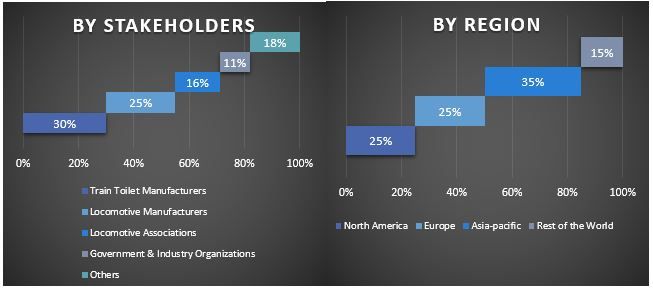
시장 엔지니어링
전반적인 시장 추정을 완료하고 글로벌 기차 화장실 시장의 각 세그먼트 및 하위 세그먼트에 대한 정확한 통계 데이터를 도출하기 위해 데이터 삼각 측량 기술이 사용되었습니다. 글로벌 기차 화장실 시장에서 유형별, 용도별 등 다양한 매개변수와 트렌드를 연구한 후 데이터가 여러 세그먼트 및 하위 세그먼트로 분할되었습니다.
글로벌 기차 화장실 시장 연구의 주요 목표
글로벌 기차 화장실 시장의 현재 및 미래 시장 동향이 연구에서 정확히 파악되었습니다. 투자자는 연구에서 수행된 질적 및 양적 분석을 기반으로 투자를 위한 재량을 결정할 수 있는 전략적 통찰력을 얻을 수 있습니다. 현재 및 미래 시장 동향은 지역 수준에서 시장의 전반적인 매력을 결정하여 산업 참가자가 아직 개척되지 않은 시장을 활용하여 선두 주자의 이점을 얻을 수 있는 플랫폼을 제공합니다. 연구의 다른 정량적 목표는 다음과 같습니다.
가치(USD) 측면에서 글로벌 기차 화장실 시장의 현재 및 예측 시장 규모를 분석합니다. 또한, 다양한 세그먼트 및 하위 세그먼트의 현재 및 예측 시장 규모를 분석합니다.
연구의 세그먼트는 유형별, 용도별 영역을 포함합니다.
글로벌 기차 화장실 산업에 대한 규제 프레임워크를 정의하고 분석합니다.
다양한 중개인의 존재와 관련된 가치 사슬을 분석하고 산업의 고객 및 경쟁사 행동을 분석합니다.
주요 지역의 글로벌 기차 화장실 시장의 현재 및 예측 시장 규모를 분석합니다.
보고서에서 연구된 주요 지역의 국가는 북미(미국, 캐나다 및 북미 나머지 지역), 유럽(영국, 프랑스, 독일, 이탈리아, 스페인, 유럽 나머지 지역), 아시아 태평양(중국, 일본, 인도, 아시아 태평양 나머지 지역), 세계 나머지 지역을 포함합니다.
글로벌 기차 화장실 시장의 회사 프로필 및 빠르게 성장하는 시장에서 생존하기 위해 시장 참여자가 채택한 성장 전략.
산업에 대한 심층적인 지역 수준 분석
자주 묻는 질문 자주 묻는 질문
Q1: 글로벌 열차 화장실 시장의 현재 시장 규모 및 성장 잠재력은 무엇입니까?
글로벌 열차 화장실 시장은 2023년에 14억 3천만 달러의 가치를 기록했으며, 예측 기간(2024-2032년) 동안 연평균 성장률(CAGR) 3.44%로 성장할 것으로 예상됩니다.
Q2: 글로벌 열차 화장실 시장 성장의 동인은 무엇입니까?
개발 도상 지역에서 열차를 이용하는 승객의 증가가 성장의 주요 동인 중 하나입니다.
Q3: 유형별 글로벌 열차 화장실 시장에서 가장 큰 점유율을 차지하는 세그먼트는 무엇입니까?
바이오 화장실 세그먼트가 유형별 글로벌 열차 화장실 시장에서 가장 큰 점유율을 차지합니다.
Q4: 어떤 지역이 글로벌 열차 화장실 시장을 지배할 것인가?
아시아 태평양이 예측 기간 동안 시장을 지배할 것으로 예상됩니다.
Q5: 어떤 지역이 전기 강재 시장을 지배할 것인가?
APAC가 예측 기간 동안 시장을 지배할 것으로 예상됩니다.
관련 보고서
이 상품을 구매한 고객님들도 함께 구매하신 상품


